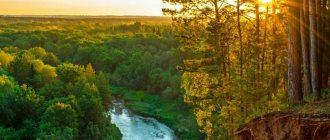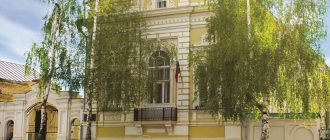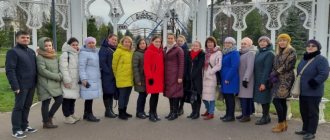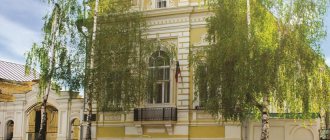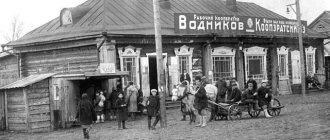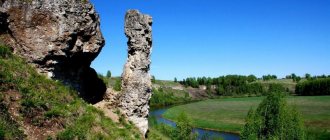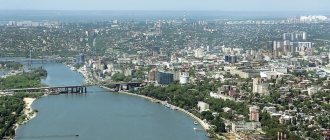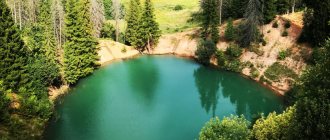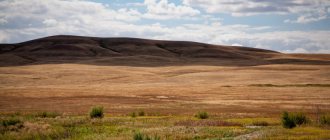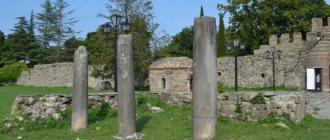Museum-Estate of P.I. Tchaikovsky in Votkinsk
State memorial and architectural complex “Museum…
Votkinsk
The museum named after the great composer was opened in 1940 in the homeland of Pyotr Tchaikovsky - in Votkinsk. The estate where the exhibition is located was built in 1806 for the heads of the ironworks. Around the old house there is a garden with centuries-old linden trees. In it, gazebos in a classical style are recreated according to ancient drawings.
The Tchaikovsky family lived here for 11 years, from 1837 to 1848. The exhibition features a restored interior of a house from the mid-19th century. The museum houses antique furniture, lamps, paintings, dishes, books and sheet music. One of the most valuable exhibits is the Wirth grand piano, on which Pyotr Tchaikovsky learned to play.
The large hall of the museum hosts classical music concerts, theatrical performances and literary evenings.
Presentation “Monuments and sculptures of Izhevsk”
To view the presentation with pictures, design and slides, download its file and open it in PowerPoint on your computer. Text content of the presentation slides: MONUMENTS AND SCULPTURES OF IZHEVSK The Pelmenu monument opened in October 2004.
It is located near the Pozim cafe, on Kraeva Street. The monument looks as if a large hand took a fork and stabbed a dumpling on it, and then stuck the fork into the ground with the blunt end. The size of the dumpling in diameter is 1 meter. The height of the structure with the plug is 3 meters. Monument to Dumplings Monument to Dumplings Monument to A.F. Deryabin. Installed in 1907 according to the design of the self-taught sculptor I.N. Sitnikov in connection with the 100th anniversary of the Izhevsk Arms Factory. Height 3 m, bronze bust 1 m high, lanterns and cabinets with chains installed in 1956 (Izhevsky Pond embankment, Deryabin passage). Monument to A.F. Deryabin Monument to A.F. Deryabin Main building with the tower of the Izhevsk Arms Plant. A monument to Russian industrial architecture of the 1st half of the 19th century. The style is high classicism. The main building with the tower of the Izhevsk arms factory. The main building with the tower of the Izhevsk arms factory. Monument to Grand Duke Mikhail Pavlovich. This is the only monument in Russia to Grand Duke Mikhail Pavlovich Romanov, who headed the Artillery Department. The Izhevsk arms factory, which produced weapons during the Patriotic War of 1812, was also subordinate to him. In the 30s of the 20th century, the monument was demolished, but in 2007, the Archangel Michael crowning the 20-meter column again took its historical place on the gunsmiths' square. Monument to Grand Duke M.P. Romanov. Monument to Grand Duke M.P. Romanov. Monument to the hero of the revolution and civil war, chairman of the Izhevsk City Council of Workers' and Peasants' Deputies I.D. Pastukhov. Cast iron. Installed in 1933 according to the design of the sculptor I.S. Efimov, in 1968 it was moved from the former central square (corner of Sovetskaya and Gorky streets) to the intersection of the street. Krasnogeroiskaya and Kommunarov. Located on the state security educontest.net
Museum-reserve "Ludorvai"
Architectural and Ethnographic Museum-Reserve "Ludorvai"
Zavyalovsky district
What is a tarantass? What do the bottom ends look like from the fairy tale about Kolobok? Why did the Udmurts build houses without floors and ceilings? Why, when entering a national home, the first thing you need to do is touch the stove? All this can be found out in the architectural and ethnographic complex “Ludorvai”.
The open-air museum consists of ancient wooden buildings. Some of them were originally built here, and some were brought from other settlements. Guests will see huts and a barn, a stable and a bathhouse on the territory of the museum-reserve, as well as a kuala, a family sanctuary in which important ceremonies were held.
One of the oldest buildings is a windmill with a recreated mechanism and wooden utensils. The exhibition tells about the life and history of the Udmurts, Besermyans, and Russian settlers. Inside the buildings you can see rugs and dishes, carts and national clothes.
On the territory of the museum there are excursions, festivals and folk festivities for holidays - Maslenitsa, Peter's Day, Honey Savior. Visitors are offered interesting photo sessions and tastings of Udmurt dishes.
Mountains - beautiful places in Udmurtia
There are no real high mountains of solid rock on the territory of the republic, but there are several notable hills.
Mount Kargurez
- Coordinates: 57.359763, 53.896001.
This peak on the territory of the Sharkan nature reserve has several names: Kargurez, Kar-gora, Yablonovaya mountain. The word "car" has two main meanings: "nest" and "city". Centuries ago, at the foot of the remnant there was a settlement, and on the slopes covered with forests, prayers and festive celebrations took place.
Today archaeological research is periodically carried out on Kargurez, scientists are looking for traces of a settlement of the 18th century. Tourists come to Kar Gora to enjoy the magnificent panorama and get water from the local spring. From the top you can view the surrounding area within a radius of 25 km.
Tatar hill
- Address: s. Pudem, Yarsky district.
The picturesque hill is located in the Tatar Grove tract, a few kilometers from the village of Pudem. According to ancient legend, during the time of the Golden Horde, Tatars passed through these regions. The Tatar Khan’s beloved daughter died, and the inconsolable father ordered his soldiers to build a huge hill over the girl’s grave.
Today, the slopes of the mountain are covered with low grass, while the top is decorated with a kind of “cap” of trees. In a small grove, as well as in a tract, there are pines, birches, spruces, rowan trees, etc. In autumn, the leaves of the trees turn bright colors, making the Tatar Hill even more beautiful.
Babinskie Mountains
- Address: Russkaya Babya village.
Several low mountains near the village of Russkaya Babya were formed many centuries ago as a result of glacier movement. Well-trodden paths lead to the green peaks; locals and visitors love to walk here and pick berries. A river flows at the foot of the hill, which offers a wonderful view from the high slopes. Sometimes folk festivals and excursions for children are held on the mountain.
Bashenin's dacha in Sarapul
Art and exhibition complex "Dacha Bashenina"
Sarapul
The estate was built in 1909 for the mayor of Sarapul, Pavel Bashenin. The Art Nouveau building was designed by architect Pavel Trubnikov. The house was built of stone and decorated with Gothic verandas, bay windows and balconies of various shapes. After the revolution, the building at various times housed a sanatorium for the homeless, a commissariat, a surgery and a children's sanatorium.
The first museum exhibits appeared here in 1991. The collection includes paintings by Russian and European artists of the 19th and early 20th centuries, furniture and dishes. And on the territory of the estate itself, outbuildings, a stable, a cobblestone street, a fountain and a park have been preserved.
Museum-reserve "Idnakar"
Historical and Cultural Museum-Reserve of the Udmurt Republic…
Glazov
Not far from the city of Glazov, on the site of the Chepetsk settlement, the Idnakar museum-reserve is located. According to legend, it was founded by the Udmurt hero, Prince Idna. The city is named after him. In the 9th–13th centuries, Idnakar was the capital of the craft, trade and cultural life of the Udmurts. Merchants from many countries of the world brought their goods here.
At the end of the 20th century, at the site of the ancient settlement, archaeologists discovered the remains of dwellings and household items of the ancient Udmurts. They made up the collection of the Idnakar museum-reserve. In total, the exhibition includes about 500 items: stone tools of the Mesolithic era, pottery, models of medieval dwellings, weapons, armor, jewelry and clothing of the Finno-Ugric peoples.
National Park "Nechkinsky"
National Park "Nechkinsky", Udmurt Republic. Photo: nechkinsky.ru
Nechkinsky National Park is one of the natural attractions of Udmurtia. It was created in 1997 to preserve the nature of the Middle Kama region: taiga forests, endangered peat bogs and fauna. The park contains ancient pine forests, sandy beaches and lakes. There are 104 species of plants and animals listed in the Red Book. The national park contains several historical cultural monuments: the Church of the Epiphany in the village of Nechkino and places associated with the childhood of Pyotr Tchaikovsky.
You can walk around the territory on foot or order a car route, kayaking, or skiing. There are also houses for rent on the shore of the lake for tourists.
Other sights of the Udmurt Republic
In all corners of Udmurtia there are hidden various natural monuments that are atypical for this region. Small waterfalls, caves, canyons are real diamonds for ecotourism lovers.
Waterfall in the village of Kezdur
- Coordinates: 57.835760, 53.680925.
Waterfalls are a rare phenomenon for Udmurtia. Kezdur Waterfall is a small stream running down the red-orange slope of a high hill. A small, but quite stormy and noisy stream flows down the clay soil, breaks off a small ledge and flows into the Lyp River.
There is a steep descent to the foot of the hill; the steps are made of old car tires, partially dug into the ground and filled with stones. For the convenience of tourists, a railing is built next to the stairs.
Abat caves
- Address: Staraya Bodya village, Kiznersky district.
An unusual surprise awaits guests of the village of Staraya Bodya: in the middle of the plain, three-meter caves suddenly appear in front of tourists. The caves got their name from the Abat River, which flows through the village. Almost no sunlight penetrates into the moss-covered stone chambers, so they are cool even in hot weather.
Cape of Love
- Coordinates: 55.991098, 53.658511.
The most romantic place on the banks of the Kama. The elevation offers a dizzying view of the river, surrounding meadows, spreading pine trees and small settlements at the foot of the cape. In spring, the cape is covered with fragrant flowers and herbs. The picturesque peak has long been chosen by loving couples and newlyweds; dates are often held here, photo sessions are held and declarations of love are heard.
Chemoshur-Uchinsky Canyon
- GPS coordinates: 56.637409, 52.264859.
The canyon of the Chemoshur River near the village of Chemoshur-Ucha is an amazingly beautiful place, shrouded in an aura of mysticism. Clear streams flow down the green walls of the canyon, and a clear river flows at the bottom, in which you can see literally every pebble. In some places, the greenish sandstone changes to bright red with white stripes.
The incredibly beautiful cliff could serve as a natural setting for science fiction films. There are also two small but colorful waterfalls in the canyon. The area of the attraction is especially beautiful in winter, when part of the water freezes and turns into ice floes, along which a noisy stream continues to run.
You may also be interested in interesting places in the regions neighboring Udmurtia - Kirov region, Perm region, Bashkortostan and Tatarstan
Tol Babai Estate
Tol Babai estate, Sharkan village, Udmurt Republic. Photo: tolbabay.net
In the village of Sharkan, the Udmurt Father Frost, Tol Babai, lives in his residence. On the territory of the estate there is a wooden hut decorated in New Year's style, a House of Craftsmen, a children's playground and a cafe.
Together with his granddaughter, Tol Babai invites guests to ride sleighs, tubes and cheesecakes, ATVs and horses, and jump on trampolines. Visitors to the estate can also look into the house of the Udmurt Baba Yaga Obyda and take part in folk games and rituals.
Unlike the Russian Father Frost, Tol Babai also receives guests in the summer. When the weather warms up, his residence hosts concerts and theatrical performances.
Museum "Step point of the Siberian Highway"
Museum “Step point of the Siberian Highway”, Bachkeyevo village, Udmurt Republic. Photo: vk.com
The building housing the Siberian Highway Stage Museum was built in 1837. In the 19th century, prisoners who were sentenced to exile to Siberia stayed here. Since 1900, the house housed first a two-class zemstvo school, and then the Bachkeevskaya school.
In 2000, a museum was placed in the ancient building. It is included in the tourist route “Siberian Highway - the road through the centuries.” Visitors are told about prison life: here you can see shackles, ride a cart and eat the food that was offered to prisoners.
Author: Marina Smolyanaya
Unusual trees of the Republic
A significant part of the Republic of Udmurtia is covered with forests. Some trees stand out from others due to their age, unusual shape or amazing history and are recognized as natural monuments.
Egorovskaya pine
- Address: Egorovtsy village, Seltinsky district.
A remarkable pine tree near the village of Yegorovtsy stands out among other natural monuments due to its venerable age and colossal size. The prickly old-timer, standing alone in the middle of the meadow, is already more than 500 years old.
The height of the pine tree is about 30 meters, the girth is more than 5 meters. The unique tree has two honorary titles at once: “the tallest pine tree in the republic” and “the widest coniferous tree in girth.”
Relict pine in Zur
- Address: s. Zura, Igrinsky district.
An old tree grows alone on the top of a hill near the village of Zura. For more than three and a half centuries, the long-lived pine has been observing the course of life and the change of eras. For a long time, local residents did not know how long the pine queen reigned on the hill.
In 2012, specialists from the Moscow center were able to establish the approximate age of the tree – 360 years. The mighty beauty is the only large plant on the hill; except for short grass, nothing takes root on the hill. In August 2011, the unique pine was included in the register of old-growth trees.
Sosna-Bort
- Coordinates: 57.203833, 53.160517.
Another amazing century-old pine tree grows near the village of Yakshur-Bodya. The height of the tree is about 20 m, the wide straight trunk is crowned with a spreading crown. At a height of about 3 meters, a narrow vertical crack appears black in the trunk - the side where wild bees used to live. It is believed that it was thanks to the extraction of honey from this hive that beekeeping flourished in local villages.
Since ancient times, beads have been hollowed out directly in the trunks of living trees; only centuries later people began to make beads in chocks and place them in apiaries. Today, hives are made from boards, and beekeeping has sunk into oblivion. There are practically no trees with edges left in the region; the pine near Yakshur-Bodya is one of the few surviving specimens.
Devil's tree
- Coordinates: 57.586894, 53.214078.
The most mysterious and gloomy tree in Udmurtia is located near the village of Igra. The withered, blackened pine has a dark past; many terrible stories and legends are associated with it. Hundreds of years ago, the infamous Siberian Highway ran past the tree, along which shackled prisoners were driven to hard labor. In the same area, robber gangs operated, robbing trade carts and ordinary people.
According to one legend, a tall pine tree absorbed the blood and suffering of innocent victims and dried up from the evil and grief that the merciless criminals brought. Today, the ebony tree stands out among its green neighbors and reminds of the atrocities that happened on Igrinskaya land. The only living things in the dead trunk are wild bees that have settled in the dry hollow.
Alenskaya spruce
- Address: Alen tract, Kezsky district.
Not far from Kez there grows a giant long-lived spruce. The height of the miracle tree is 25 meters, the width of the girthless trunk is about 3 meters. The coniferous giant has been towering in the Alen tract for almost two centuries.
In the old days, the Udmurts considered spruce sacred and created legends about it. Many years ago, during a severe thunderstorm, lightning struck the record holder at a height of 6 meters and split the trunk into two parts.
Even after such a serious test, the tree did not die and continued to grow. In March 2012, the natural monument was included in the list of old-growth trees. Today, the road to the centenarian is one of the most popular tourist routes in the Kez region.
Pander cedars
- Address: Sarkuz station, Kiznersky district.
Two Siberian cedars near the Sarkuz station are all that remains of the disappeared village of Panderka. Centuries-old trees were planted during the life of the village and witnessed its death. In 1912, several families from Staraya Panderka moved to Siberia, but soon returned to their native lands. One of the families brought with them about 50 cedar seedlings, 20 of them successfully took root in the new land. The “Siberians” quickly grew and within a few years reached 2-3 meters in height.
After the Revolution, collectivization began, and agriculture began to actively develop. Local communists cut down almost all the cedars; only two trees miraculously escaped the bitter fate of their fellows. The surviving cedars survived the offenders and many villagers. Years later, the village was deserted, but the long-lived trees still delight the eye with their lush crowns and powerful stature.
